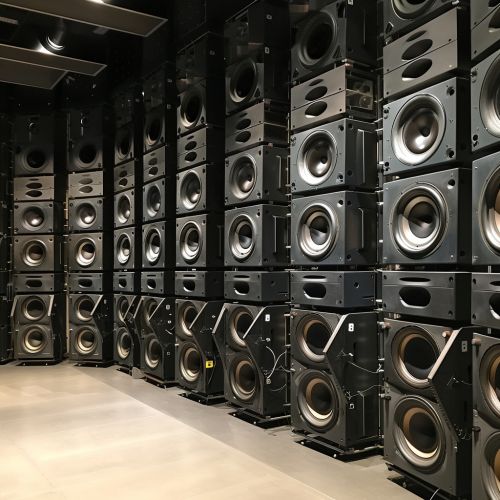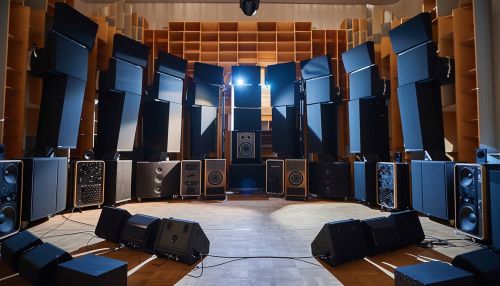Wave Field Synthesis
Introduction
Wave Field Synthesis (WFS) is an advanced spatial audio rendering technique that aims to create a realistic auditory experience by reconstructing the sound field in a given space. This method is based on the principles of Huygens' principle and the Kirchhoff-Helmholtz integral. WFS allows for the precise control of sound waves, enabling the creation of virtual acoustic environments that can be experienced by listeners regardless of their position within the listening area.
Principles of Wave Field Synthesis
Huygens' Principle
Huygens' principle states that every point on a wavefront can be considered as a source of secondary spherical wavelets. The sum of these wavelets forms the new wavefront. This principle is fundamental to WFS, as it allows for the reconstruction of sound fields by superimposing the contributions of multiple loudspeakers.
Kirchhoff-Helmholtz Integral
The Kirchhoff-Helmholtz integral provides a mathematical framework for describing the propagation of sound waves in a given space. It states that the sound pressure at any point in a volume can be determined by the sound pressure and its gradient on the boundary of the volume. This integral is used in WFS to calculate the driving signals for the loudspeakers.
Implementation of Wave Field Synthesis
Loudspeaker Arrays
WFS systems typically employ large arrays of closely spaced loudspeakers. These arrays can be linear, circular, or spherical, depending on the desired application. The spacing between the loudspeakers is crucial, as it determines the frequency range over which the system can accurately reproduce the sound field.
Signal Processing
The driving signals for the loudspeakers are computed using the Kirchhoff-Helmholtz integral. This involves calculating the contributions of each loudspeaker to the desired sound field and summing them to obtain the overall sound pressure at each point in the listening area. Advanced signal processing techniques, such as Fast Fourier Transform (FFT) and Finite Element Method (FEM), are often employed to optimize the computation.
Acoustic Rendering
The goal of WFS is to create a virtual acoustic environment that is indistinguishable from a real one. This involves not only accurately reproducing the sound field but also taking into account factors such as room acoustics, listener position, and head-related transfer functions (HRTFs). By carefully controlling these parameters, WFS can create highly immersive auditory experiences.


Applications of Wave Field Synthesis
Virtual Reality and Augmented Reality
WFS is particularly well-suited for applications in virtual reality (VR) and augmented reality (AR). By providing a realistic and immersive auditory experience, WFS enhances the sense of presence and immersion in virtual environments. This is crucial for applications such as gaming, training simulations, and virtual tours.
Concert Halls and Theaters
WFS can be used to enhance the acoustic experience in concert halls and theaters. By precisely controlling the sound field, WFS can create the illusion of different acoustic environments, such as a cathedral or a small chamber, within the same physical space. This allows for greater flexibility in the design and use of performance venues.
Audio Production and Broadcasting
In audio production and broadcasting, WFS can be used to create more realistic and immersive soundscapes. This is particularly useful for applications such as film soundtracks, radio dramas, and live event broadcasts. By accurately reproducing the spatial characteristics of the sound, WFS can enhance the listener's experience and provide a more engaging auditory experience.
Challenges and Limitations
Computational Complexity
One of the main challenges of WFS is the high computational complexity involved in calculating the driving signals for the loudspeakers. This requires significant processing power and can be a limiting factor in the implementation of WFS systems.
Loudspeaker Array Design
The design of the loudspeaker array is critical to the performance of a WFS system. The spacing and arrangement of the loudspeakers must be carefully optimized to ensure accurate reproduction of the sound field. This can be challenging, particularly for large arrays or complex geometries.
Room Acoustics
The acoustic characteristics of the room can have a significant impact on the performance of a WFS system. Factors such as reflections, absorption, and diffusion must be carefully managed to ensure accurate reproduction of the sound field. This often requires detailed acoustic modeling and optimization.
Future Directions
Advances in Signal Processing
Ongoing research in signal processing techniques is expected to improve the performance and efficiency of WFS systems. This includes the development of more efficient algorithms for calculating the driving signals, as well as techniques for real-time adaptation to changing acoustic environments.
Integration with Other Technologies
The integration of WFS with other technologies, such as beamforming and ambisonics, is an area of active research. By combining these techniques, it may be possible to create even more realistic and immersive auditory experiences.
Miniaturization and Portability
Advances in loudspeaker technology and signal processing are expected to lead to the development of more compact and portable WFS systems. This could enable new applications, such as personal audio devices and portable VR/AR systems.
